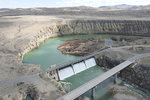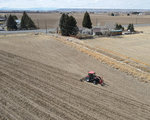Cloudy, 57° F
Spring rains are helping to quench a thirsty Wyoming, but it’s not quite enough to lift the state out of a drought. On top of high fertilizer and fuel prices, the drought is making 2022 a …
This item is available in full to subscribers.
The Powell Tribune has expanded its online content. To continue reading, you will need to either log in to your subscriber account, or purchase a subscription.
If you are a current print subscriber, you can set up a free web account by clicking here.
If you already have a web account, but need to reset it, you can do so by clicking here.
If you would like to purchase a subscription click here.
Please log in to continue |
|


Spring rains are helping to quench a thirsty Wyoming, but it’s not quite enough to lift the state out of a drought. On top of high fertilizer and fuel prices, the drought is making 2022 a tougher year for the state’s farmers.
As of April 30, the Powell Field Station, which is north of Powell, reported the total rainfall for the year at 0.77 inches. The normal for this point of the year is an inch.
While we’re still below normal, the situation is much improved from a week prior when the total rainfall for 2022 was just 0.23 inches, below the normal of 0.81. At that point, the moisture for the year was on track to be at the same level as 1985, when the station recorded the lowest rainfall in its history.
Despite the improvement, most of the state remains in severe to extreme drought.
Farmers in the Big Horn Basin enjoy a network of irrigation canals fed by the Buffalo Bill Reservoir. As long as the storage in the reservoir is good, farmers will have the water they need for their crops.
It’s been decades since that supply was severely stressed, and it’s likely been since the 1970s when farmers’ allotments were restricted. However, due to the ongoing drought of the past couple years, the reservoir is low.
In January, snowpack in Yellowstone National Park through the Big Horn Basin was about 87% to 96% of the median, which is taken over a 30-year period, from 1991 through 2020. As of May 1, the amount has climbed from 94% to 103% of the median. This means the reservoir storage will be good next year.
For farmers this season, the past week’s rain was routine weather variability, which is good and bad.
“If it could have waited a week, then it would have been great,” said Powell-area farmer Paul Faxon.
He said rain is always good, but if the crops are planted prior to the rain, it’s a lot better.
David Northrup, who farms on the Willwood, said the impact was minimal.
“It’s not enough to do much other than get the ground wet,” Northrup said.
Making the fields wet can also delay planting, as the equipment doesn’t do well with a lot of mud. However, things were dry on Sunday. By Monday, farmers were back at it.
“I’m not complaining. It settled the dust. I’ve had dust on my boots since November,” Northrup said. “It was a nice weekend. I had some time to spend with my wife, and now we’re back at it.”
With irrigation flowing adequately, Basin farmers will have the moisture they need. However, fertilizer and fuel prices are double and triple what they were a year ago, which will hit farmers’ bottom line.
“It’s just ridiculous. The agricultural world is turned upside down,” Northrup said.
In some parts of the country, as well as the world, farmers are reducing the amount of fertilizer application. This will play out with reduced food supplies and higher prices at the grocery store next year.
Northrup said while he’s being more careful to maintain efficient application, he hasn’t reduced his fertilizer application on his fields.
Likewise, many farmers contracted their fuel and fertilizer last fall, which will help keep those costs down.
So long as there aren’t any extreme weather events, especially come harvest time, the area’s agricultural industry will make it through this hard year. And there aren’t really easy years for a farmer.
As Faxon pointed out, difficult weather is something farmers have come to expect.
“You go through it every year,” Faxon said. “It is what it is.”